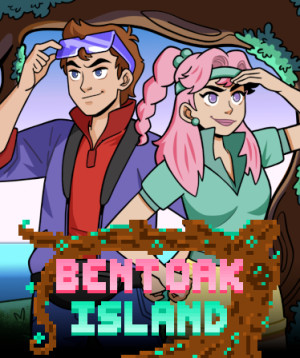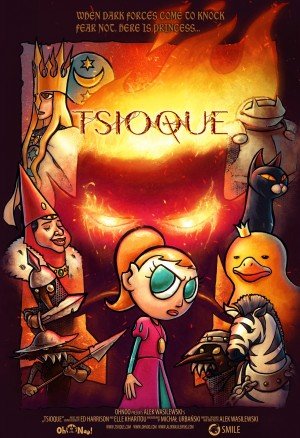Review for Illusion: A Tale of the Mind

Like movies that don’t get advance screenings, it’s usually not a good sign when a game is released with zero publicity, no marketing efforts or review codes sent to press even when requested. More often than not, it soon becomes clear why it’s been neglected and quietly abandoned like a shameful little secret. So it was with more than a little trepidation that I began Illusion: A Tale of the Mind, a game I wouldn’t have even known about if I hadn’t tripped over it by accident. Yet I couldn’t resist the lure of its gorgeous dreamlike artwork and promise of a twisted psychological storyline. And am I ever glad I didn’t! It’s a flawed game, to be sure, with some frustrating and repetitive design issues straining against full enjoyment on occasion. But what it does well, it does superbly, so whoever decided this game deserved no PR attention whatsoever was obviously nuts.
Illusion begins oddly, and only gets weirder from there. A young white-haired girl named Emma awakens in a dark cave to find herself chained to a pair of giant Comedy and Tragedy masks. This is no laughing matter, but fortunately a floating plush bunny with button eyes and a pull string comes to Emma’s rescue and magically turns her chains into a long, ethereal scarf. The rabbit is Topsy, who seems to know Emma’s name but not much else. Indeed, lost memories become a major focus of their shared adventure from that point on. Between cutscene-inducing photographs, collectable posters and scattered gramophone recordings, the pair begin piecing together the story of a broken-hearted former carnival strongman named Euclide. What does Emma have to do with the man, and why is she being continually taunted by a giant eyeball who’s hell-bent on her destruction? That’s what you’ll need to find out… or not.
Unfortunately, the narrative is one of the game’s weaker areas when it could have been one of its strengths. While amnesiac protagonists finding fragmented memory triggers is a common approach and works well when done right, it’s both far too heavy-handed here and yet still annoyingly cryptic. You’ll have sorted out the essential character details long before Emma, and yet you’ll keep getting hammered over the head with more, undermining what could have been quite a poignant love story. What’s worse is that for all its exposition, the question of why (or how) you and Topsy are trapped in this imaginary(?) nightmare with such a malevolent entity is really never explained. More importantly – and I can’t say much for fear of spoiling what’s meant to be a significant “gotcha!” reveal – Emma herself is ultimately relegated to a minor footnote in her own backstory. It’s a huge omission that strips away much of the motivation to care about what happens, though you’d have to be heartless to not feel a bit of compassion for the tormented big lug whose memories you seek to restore.
That said, it’s all so surreal that you’ll be willing to roll with the gaping plot holes simply to soak up the rich atmosphere. Divided into distinct chapters, you’ll make your way through three central hub worlds consisting of a 1920s Parisian circus, a World War I battlefield (and the deadly skies above it), and perilous goo-infested caverns. The 3D graphics are gorgeously vivid, and the environments frequently pop (or BOOM) with animation. Like a dream that seems familiar but just a little “off”, this world genuinely feels like a distorted version of the real thing. Most of the buildings are warped and curved with unnatural lines, and the carnival is hewn out of massive rock caverns against a lovely pink sky. There you’ll find a Ferris wheel and carousel, as you’d expect, but also floating islands, elephant carriages hoisted by balloons, and a giant lollipop tree. The depiction of war that follows is all too real in many ways, but here the trenches are populated with ghostly spectres and presided over by bi-planes shaped like eagles. Other scenes are even more fantastical, such as the inside of a shattered heart, and a labyrinth of stone columns, statues and portals nested in the clouds.
It helps that the animation really brings these creative worlds to life. It’s most noticeable in the startlingly chaotic WWI chapter – the ground continually bombarded by artillery, the skies filled with frantic dogfights and exploding planes, while smoky walls are haunted by multitudes of disembodied grasping hands. Although there is no actual danger from background threats, there are certain times when you must evade living ooze monsters in frenzied chase sequences. One scenario has you dodging concussive blasts from the end of a long corridor, and the blowback feels completely authentic when caught out in the open. Even at leisure, the protagonists move fluidly throughout, with Emma’s flowing white scarf trailing delightfully behind her to give a proper sense of motion, and Topsy gently bobbing faithfully nearby.
Adding to the otherworldly feel are some deliciously crooked angles. The camera tracks Emma and Topsy as they freely move (usually together) through the environments, but occasionally the view will slant deliberately askew, even completely sideways. It’s not physically harder to maneuver through tilted scenery, but it’s effectively disorienting in reminding you that you’re trapped in a twisted mindscape. Expect to find yourself instinctively cocking your head to one side from time to time in a futile attempt to regain your own equilibrium.
The wonderfully eclectic music is equally adept at providing suitable accompaniment. From lilting accordions conjuring up feelings of old-timey Paris cabarets, to whimsical outdoor carnival tunes, to haunting strings and occasional vocals, you’ll be immersed just as much in the sounds of Illusion as you are its glorious sights. During the more anxious action sequences, the score ramps up to a driving, discordant rock riff that will help to get your blood flowing faster, as if you needed any further incentive. Sound effects, too, are important in establishing the terrifying tone of battle, though they’re far less pronounced elsewhere.
The game is fully voiced and the actors all do a good job, though I found the heavily-accented Euclide sometimes hard to understand. The same is true for the high-pitched Topsy and the evil eyeball’s thunderous bass, though with them it was because the audio has been deliberately altered to sound less human. I generally don’t like to play with subtitles on, but was forced to here because I was missing too much. Oddly, sometimes there’s nothing to do but stand and listen to lengthy recordings when you’d really rather get on with exploring, while other times the garbled voice of your menacing unseen opponent won’t shut up when you have the least time to listen. It’s intimidating, but not very helpful. Emma sounds entirely age-appropriate, conveying a nice mix of youthful innocence and determined resolve. My only issue with her is that she soon starts panting when exerting herself, which doesn’t slow her down but does get overbearing.
If it sounds so far like Illusion is more of an action game than adventure, rest assured that is not the case. Apart from the chase sequences, which mostly require a steady hand under duress rather than fast reflexes, there is some light platforming as well. At first there’s so little to these you don’t even need to jump, as Emma will do so automatically when you position her at a ledge. Later they do become actual challenges, however, not only by adding manual jumps but crumbling ice platforms to land on, making timing more essential. You’ll probably die a number of times here and there, but you’re generally restored to a point just before the fateful moment, except for a few obnoxious occasions that reset a whole sequence to the beginning. The most egregious of these that really gave me fits was a precisely-timed dash through a gooey maze that alternated safe positions. Even when knowing precisely where to go, it was still a challenge to get there in the split-second opportunities provided.
In between the running and jumping, most of your time will be spent searching for multiple item fragments (mirror shards, battery pieces, etc.) needed to progress, and solving puzzles along the way. There’s a degree of non-linearity in exploring, though some tasks must be completed before others can be fully accessed. At first I quite enjoyed the puzzles on offer, whether rotating circles to align their designs, directing light through gapped rings to illuminate objects in the center, or flipping weirdly-shaped pieces to project the correct pattern in silhouette. I particularly liked the more organic obstacles, such as using coloured contraptions to reshape aspects of the environment (gates, bridges, blockages), and moving to the proper position on parallax-scrolling maps to synchronize seemingly random elements to form a familiar shape, often after manipulating the pieces into their correct places first. The latter became increasingly frustrating, however, as the connected elements bore less and less resemblance to their target images.
The real issue with Illusion’s puzzles, unfortunately, is that the same few types are repeated over and over, just getting more difficult as you advance. What was fun the first couple times stops being so entertaining the fifth or sixth time around. Some of them suffer from finicky controls too. The game can be played with either keyboard/mouse or gamepad, and for the most part handles smoothly using either. However, trying to cycle through numerous tangram pieces, then rotating them into the correct position, then placing them tightly together is a nuisance with a controller, and it’s very easy to accidentally click the “back out” button instead of “drop piece” button, which resets the entire puzzle. Auggh!!
But that little foible is nothing compared to one of the dumbest interface whoppers I’ve ever encountered in a game. You know how when you escape to a main menu, the “start game” option is at the top, and the “quit game” option is at the bottom? Well, yeah… no. Not here. Not only is there NOT a “quit game” option at all (you need to unintuitively select the “back” option listed way off on the other corner of the screen instead), but where “quit game” appears 99% of the time is where “reset game” is listed here. Suuuure easy to click that instinctively if you’re not paying close attention. Of course, no game would ever allow you to completely zap your one and only autosave file without a warning first, right? Wrong! With no way to manually save your game, one errant click on the atrociously-designed menu screen can wipe out hours of progress. Technically the fault was my own when it happened to me, but it’s much easier to blame the game, so I will.
Some people enjoy replaying games, but I despise it, and since there’s really no special incentive to do so in Illusion, I was not pleased to have to start all over from the beginning after getting about halfway through. It’s a testament to the quality of the experience itself, then, that I really didn’t mind the time spent getting back to where I was. It didn’t make the repetitive puzzles any fresher, that’s for sure, but it was a joy to drink in the sights and sounds and atmosphere once again. My unintended mishap makes it hard to gauge the length of the game, but I would estimate about 5-6 hours a single time through.
Even without that colossal faux pas, this game is not without its speed bumps. From a lack of variety in its puzzles to odd story decisions that don’t even ultimately pay off in a satisfying ending, it’s isn’t the best-rounded adventure available. And yet rarely have I felt so immersed in a world, at least in recent years, or enjoyed my time spent in it this much. With top-notch production values, endearing main characters, a pleasing amount of physical gameplay to go with its more cerebral challenges, and an extra dose of je ne sais quoi, I heartily recommend Illusion: A Tale of the Mind to all those who had never even heard of it before now, or knew very little about it even if you did. Don’t be deceived by its lack of publicity: the good times are very real.
WHERE CAN I DOWNLOAD Illusion: A Tale of the Mind
Illusion: A Tale of the Mind is available at:
We get a small commission from any game you buy through these links (except Steam).Our Verdict:
Seeing (and hearing, and playing) is believing, so do yourself a favour and check out Illusion: A Tale of the Mind, a flawed but wonderfully immersive and inexplicably-unheralded little 3D platforming adventure.




























